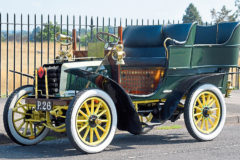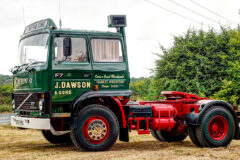1986 Ford 7610 still working!
Posted by Chris Graham on 22nd December 2022
Scott Lambert meets Jamie Rule and his 1986 Ford 7610 Force II; a working classic that’s still very much earning its keep.

EP Brand (Farmers) Ltd has recently added this 1986 Ford 7610 Force II to its fleet of JCB and New Holland tractors.
Being sensible with your money is as relevant now as it ever has been and with exorbitant purchase and running costs, buying the perfect tractor for your operation is often a compromise between what you really want and what you can justify.
EP Brand (Farmers) Ltd. farms 600 acres of Cambridgeshire fenland, in two blocks separated by a few miles, and relies upon a mixed fleet to get the work done. Regular readers will remember our look at the 1988 Ford TW-35 and 1980 Ford FW-30 that were once used by Chris Dyer and Jamie Rule, but these have since departed to make way for a 1999 Claas Challenger 45.
With the width of the FW-30 proving prohibitive on the road and not having sufficient traction to pull the farm’s Köckerling cultivator, the Claas fitted the bill nicely and also highlighted the fact that the TW-35 was being used less and less. “With prices for classics at a decent level, it made sense to cash in on them both,” said Jamie. “The two New Hollands and the Fastrac could cover any jobs not suitable for the Challenger, but there was a gap for something smaller.”
Chris added: “We ended up buying a 7810 from a local farm dispersal sale, and this is a good Jack of all trades, but we felt we could go smaller still for jobs that needed a delicate touch!
“It doesn’t make sense to spend £100,000 on a new tractor when we can get what we need from a classic – plus we’re buying the tractors that we’ve always wanted!”
“We’re owner-drivers and have to look after our tackle, as well as drive it, so it makes sense to run tractors like this – ones that we can fix ourselves and not break the bank,” Jamie explained. “We knew what we wanted, but had to find the right one.”

During the harvest season the 7610 is used with a trailer, but it’s used in conjunction with Terra tyres for rolling and fertiliser spreading.
The ‘right one’ turned out to be a 1986 Ford 7610 Force II from Oakfields at Nuthampstead, Hertfordshire, which, although in good order, was subjected to a mechanical check and cosmetic makeover before being put to work. “It doesn’t matter how old our kit is, we like it to look it’s best and you’ve got to remember that it’s an appreciating asset,” Jamie said.
Those with experience of fen soils will appreciate that four-wheel-drive can make all the difference, but not all jobs require immense traction and this is one of the reasons Chris and Jamie wanted a two-wheel-drive tractor to their fleet.
“For top work, like fertiliser-spreading and rolling, you don’t need four-wheel drive,” Chris said. “The ability to tread lightly is key and with a tractor weighing around three-and-a-half tons, fitted with the right tyres, you can do pretty much everything you need to and enjoy the benefits of a tighter turning circle and improved visibility.”
As die-hard fans of the blue oval, a 7610 was the obvious choice. With its roots in the Ford 7000, the first mainstream model to be fitted with a turbocharger, the 7610 Force II has a great pedigree, ample power and a fantastic cab. It’s a very useable machine, whilst also being one that is popular with enthusiasts and collectors and therefore a tractor that should retain its value.
Powered by a turbocharged, four-cylinder engine generating 98hp (DIN) and 377Nm (DIN) of torque at 1,600rpm, the tractor incorporates Ford’s ‘square’ design – with the same bore and stroke dimensions of 112mm (4.4in). This, the company said, permitted lower rated speeds and shorter piston travel – cutting oil consumption and wear, as well as noise.
Coupled to the engine, via a 330mm (13in) clutch is a 16-speed Dual Power transmission with floor-mounted levers. This arrangement was an improvement on the previous range, as lever travel was reduced and shifting required less effort. The lever nearest the seat controls the range (high, low and reverse), whilst the other enables one of four speeds to be selected from a logical ‘H’ pattern. Dual Power is actuated by the driver’s left heel, although this switch can prove troublesome and is often converted to a dash-mounted rocker switch or gear lever-mounted arrangement.

With its turbocharged four-cylinder engine producing 98hp (DIN), the 7610 has proved to be a good all-rounder.
At the rear, lift capacity at the hitch point is 2,664kg (5,874lb) as standard or 4,255kg (9,380lb) with the optional assistor – which this tractor has. Dual hydraulic pumps were fitted as standard to the 6610 and upwards in the Force II range, providing a capacity of 69 litres per minute (15.2gpm) at rated engine speed. Up to four double-acting spools could be specified, each with independent flow control.
A 540/1,000rpm power take-off is fitted, with 88.1hp available at the shaft at PTO speed.
Despite its modest size, the performance of the 7610 should not be underestimated. It’s a lively performer with plenty of power and great hydraulic performance and, particularly in four-wheel drive form, great traction.
Although usually associated with six-cylinder tractors, a push-pull plough system was one of the 7610’s party tricks. With a Ransomes two-furrow reversible on the front and a similar four-furrow reversible attached to the rear linkage, the 7610 had the performance to cover as much ground as much larger tractors – the weight of the front linkage and plough combining to provide additional traction to the ZF axle.
The cab, an updated version of the Sankey-built unit fitted to the first generation of Series 10 tractors, was dubbed the Super-Q and remains a nice place to spend the working day. It’s a hands-on operating experience, which Chris and Jamie like, with a full array of levers, rocker switches and analogue instrumentation. Pendant pedals and a flat floor make for comfortable driving, for all but the very tallest of operators.
Weighing in at just 3,530kg (7,700lb), the version of the 7610 seen here is light and nimble in standard form, but this particular example retains a pair of flotation-type front tyres at all times to keep the front end up – the factory-fitted 10×16 tyres having a tendency to cut into the black, fen soil. When it’s not on regular duties it is equipped with Terra tyres on the rear to enable it to leave a minimal footprint on the delicate land.

Ah, the 1980s!
It has proved to be a great investment and the ideal machine for the farm’s requirements. “It’s a brilliant tractor!” Chris said. “The right machine at the right price and one that will do exactly what we want it to. “It takes me back to when I was younger, lighter and this was a tractor that everyone wanted.”
Chris and Jamie, along with others, are proof that buying a classic to add to your working fleet is a viable alternative to buying a new or low-houred, modern tractor, as you can maintain and repair it yourself, see a good return for your money (if current trends continue) and enjoy the nostalgia!
There is also the case that what you require may not be available new. New Holland, EP Brand (Farmers) Ltd’s favoured marque, does not offer a two-wheel-drive option above the T4.75 and although this may be enough power for some, it’s a significant step down from the 103hp (BS)/98hp (DIN) Ford 7610.
It seems that, for the time being, classic models will continue to have a role on this small parcel of Cambridgeshire land – one where tractors like this can contribute to feeding the nation whilst being appreciating assets. Long live the ’80s!
This feature comes from a recent issue of Tractor & Machinery, and you can get a money-saving subscription to this magazine simply by clicking HERE





